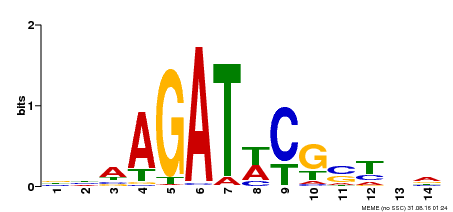| Signature Domain? help Back to Top |
 |
| No. |
Domain |
Score |
E-value |
Start |
End |
HMM Start |
HMM End |
| 1 | G2-like | 95.2 | 5e-30 | 144 | 197 | 1 | 55 |
G2-like 1 kprlrWtpeLHerFveaveqLGGsekAtPktilelmkvkgLtlehvkSHLQkYRl 55
+prl+Wtp+LH+rFv++v++L G+++A+Pkti++lm+v+gLt+e+v+SHLQkYRl
AT3G46640.1 144 RPRLVWTPQLHKRFVDVVAHL-GIKNAVPKTIMQLMNVEGLTRENVASHLQKYRL 197
59*******************.********************************8 PP
|
| Publications
? help Back to Top |
- Riechmann JL, et al.
Arabidopsis transcription factors: genome-wide comparative analysis among eukaryotes.
Science, 2000. 290(5499): p. 2105-10
[PMID:11118137] - Yamada K, et al.
Empirical analysis of transcriptional activity in the Arabidopsis genome.
Science, 2003. 302(5646): p. 842-6
[PMID:14593172] - Hazen SP, et al.
LUX ARRHYTHMO encodes a Myb domain protein essential for circadian rhythms.
Proc. Natl. Acad. Sci. U.S.A., 2005. 102(29): p. 10387-92
[PMID:16006522] - Onai K,Ishiura M
PHYTOCLOCK 1 encoding a novel GARP protein essential for the Arabidopsis circadian clock.
Genes Cells, 2005. 10(10): p. 963-72
[PMID:16164597] - Salom
Arabidopsis response regulators ARR3 and ARR4 play cytokinin-independent roles in the control of circadian period.
Plant Cell, 2006. 18(1): p. 55-69
[PMID:16326927] - Murakami M,Tago Y,Yamashino T,Mizuno T
Comparative overviews of clock-associated genes of Arabidopsis thaliana and Oryza sativa.
Plant Cell Physiol., 2007. 48(1): p. 110-21
[PMID:17132630] - Abe M,Fujiwara M,Kurotani K,Yokoi S,Shimamoto K
Identification of dynamin as an interactor of rice GIGANTEA by tandem affinity purification (TAP).
Plant Cell Physiol., 2008. 49(3): p. 420-32
[PMID:18296724] - Bieniawska Z, et al.
Disruption of the Arabidopsis circadian clock is responsible for extensive variation in the cold-responsive transcriptome.
Plant Physiol., 2008. 147(1): p. 263-79
[PMID:18375597] - Helfer A, et al.
LUX ARRHYTHMO encodes a nighttime repressor of circadian gene expression in the Arabidopsis core clock.
Curr. Biol., 2011. 21(2): p. 126-33
[PMID:21236673] - Dai S, et al.
BROTHER OF LUX ARRHYTHMO is a component of the Arabidopsis circadian clock.
Plant Cell, 2011. 23(3): p. 961-72
[PMID:21447790] - Nusinow DA, et al.
The ELF4-ELF3-LUX complex links the circadian clock to diurnal control of hypocotyl growth.
Nature, 2011. 475(7356): p. 398-402
[PMID:21753751] - Chow BY,Helfer A,Nusinow DA,Kay SA
ELF3 recruitment to the PRR9 promoter requires other Evening Complex members in the Arabidopsis circadian clock.
Plant Signal Behav, 2012. 7(2): p. 170-3
[PMID:22307044] - Sellaro R,Pac
Diurnal dependence of growth responses to shade in Arabidopsis: role of hormone, clock, and light signaling.
Mol Plant, 2012. 5(3): p. 619-28
[PMID:22311777] - Herrero E, et al.
EARLY FLOWERING4 recruitment of EARLY FLOWERING3 in the nucleus sustains the Arabidopsis circadian clock.
Plant Cell, 2012. 24(2): p. 428-43
[PMID:22327739] - Efroni I, et al.
Regulation of leaf maturation by chromatin-mediated modulation of cytokinin responses.
Dev. Cell, 2013. 24(4): p. 438-45
[PMID:23449474] - Mizuno N,Nitta M,Sato K,Nasuda S
A wheat homologue of PHYTOCLOCK 1 is a candidate gene conferring the early heading phenotype to einkorn wheat.
Genes Genet. Syst., 2012. 87(6): p. 357-67
[PMID:23558642] - Higham CF,Husmeier D
A Bayesian approach for parameter estimation in the extended clock gene circuit of Arabidopsis thaliana.
BMC Bioinformatics, 2013. 14 Suppl 10: p. S3
[PMID:24267177] - Chow BY, et al.
Transcriptional regulation of LUX by CBF1 mediates cold input to the circadian clock in Arabidopsis.
Curr. Biol., 2014. 24(13): p. 1518-24
[PMID:24954045] - Jin J, et al.
An Arabidopsis Transcriptional Regulatory Map Reveals Distinct Functional and Evolutionary Features of Novel Transcription Factors.
Mol. Biol. Evol., 2015. 32(7): p. 1767-73
[PMID:25750178] - Huang H, et al.
Identification of Evening Complex Associated Proteins in Arabidopsis by Affinity Purification and Mass Spectrometry.
Mol. Cell Proteomics, 2016. 15(1): p. 201-17
[PMID:26545401] - Huang H, et al.
PCH1 integrates circadian and light-signaling pathways to control photoperiod-responsive growth in Arabidopsis.
Elife, 2016. 5: p. e13292
[PMID:26839287] - Zhang C, et al.
LUX ARRHYTHMO mediates crosstalk between the circadian clock and defense in Arabidopsis.
Nat Commun, 2019. 10(1): p. 2543
[PMID:31186426]
|





